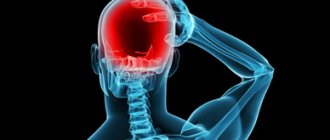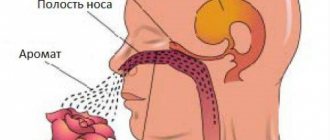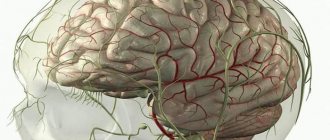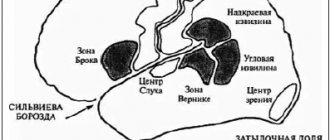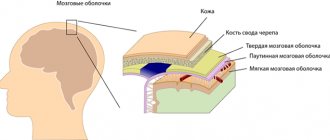The brain is the “control center” of all human life support systems. Any injuries associated with blows, bruises or wounds to the head area cause poor blood supply to brain cells and cause disruption of its functions.
Traumatic brain injury is a head injury that disrupts the integrity of the bones and skin of the skull and the functioning of the brain. Such disorders are always accompanied by characteristic symptoms of a neurotic nature. For traumatic brain injury, first aid helps prevent serious consequences of injury, facilitating treatment and recovery. Sometimes prompt medical intervention saves the patient’s life.
Causes of head injuries
Contusions, accompanied by damage to brain tissue, appear due to mechanical impact. Most often this happens for the following reasons:
- transport accidents;
- household damage;
- work injuries;
- falls from high-rise buildings.
During brain lesions, a lack of reaction and external signs are sometimes noted. This gives the misleading impression that nothing bad happened. However, in case of injury, it is imperative to consult a doctor, since the reaction often occurs late.
Classification of injuries
First aid for traumatic brain injuries is determined by the type of injury. There are 2 main classifications.
Types of brain injuries.
The first relates to possible violations of the integrity of muscles and bones:
- closed craniocerebral injury. The integrity of the tissues is not compromised. Skin lesions are possible. Most often associated with concussion;
- open. Skin tissue is severely damaged. Injury to the bones of the skull cannot be ruled out;
- penetrating. Help is required in any case, since brain tissue is affected.
The second classification is related to the type of contusion. First aid for traumatic brain injury also depends on it. The victim experiences a concussion, bruise or compression of the membranes.
Diagnosis
Among the measures to diagnose injury and determine the severity, the following are important:
- consultation with a neurologist;
- radiography necessary to determine the integrity of the skull bones;
- EchoEG is necessary to exclude the appearance of intracranial neoplasms;
- ophthalmoscopy allows you to identify vision problems and detect swelling of the optic discs;
- computed tomography scan - involves identifying hematomas and internal hemorrhages.
Symptoms
Symptoms depend on the type of lesion the patient is experiencing. It is important to distinguish the signs, since immediate assistance will depend on them:
- During a concussion, a person will experience minor damage to the membranes of the brain. The condition is primarily characterized by fainting, which usually lasts several minutes. Short-term memory loss is possible, and upon returning to consciousness, dizziness, nausea, and vomiting are noted. Signs may not appear immediately, but after some time. However, the victim in any case requires medical support;
A concussion manifests itself with dizziness, nausea, and vomiting. - a bruise is characterized by more serious tissue damage. In some cases, a fracture of the skull occurs, which provokes bleeding. With this type, bleeding from the ears or internal bleeding is possible. After a bruise, the victim also experiences fainting. It may last half an hour or longer, depending on the extent of the injury. Coma cannot be ruled out in the most severe cases. Nausea, vomiting, weakness, poor coordination of movements, and severe headache are noted. If the degree is severe, the heartbeat becomes weak, speech disappears, and convulsions appear. Urgent assistance required;
Symptoms of a head injury. - when pressure is applied to the brain tissue, hematomas, which appear with severe traumatic brain injuries, put pressure on the brain tissue. If help is not provided, the victim falls into a coma. The symptoms are the same as for a bruise, but short-term improvements in the condition are possible. If there is no help, swelling of the membranes occurs, then the person falls into a coma.
Types of TBI
Injuries are classified to diagnose the patient's condition. The rate of tissue restoration during PMP depends on the type of disorder.
| Injuries | Description |
| Severity | Light, medium, heavy |
| Type of injury | Closed (damage to gray matter and external surfaces without compromising the integrity of bones); Open (damage to the bones of the skull, in which the internal space comes into contact with the environment, which increases the risk of infection) |
| Clinical forms | Concussion, brain injury, compression of the brain or skull |
Brain concussion
A concussion is a mild degree of brain damage that may be accompanied by a brief loss of consciousness. Changes in the structure of the brain occur only at the cellular level. Identified by incision of the organ.
Clinical symptoms of TBI:
- headache;
- nausea, vomiting;
- dilated pupils;
- tinnitus;
- insomnia.
Brain contusion
Brain contusion is damage to an organ with an area of necrosis of varying sizes. According to localization, the injury can be:
- unilateral, located in the left or right hemisphere;
- bilateral, located in both hemispheres.
Clinical symptoms:
- vomiting, dizziness, nausea;
- dilated pupils;
- loss of consciousness for a time proportional to the severity of the injury;
- serious disorders of cardiovascular activity (tachycardia or bradycardia, increased blood pressure);
- internal hemorrhages are possible.
Compression
Compression of the brain is the filling of reserve spaces inside the skull with blood, depressed fractures, tumors, which lead to pressure on soft tissues.
GM compression is divided into:
- increasing, which occurs with a gradual increase in pressure on brain tissue;
- not growing, appears with depressed fractures or penetration of a foreign object into the skull.
The following substances can accumulate in the brain, causing compression:
- blood and its clots;
- cerebrospinal fluid;
- air;
- fat formations.
Clinical manifestations:
- nausea, vomiting, dizziness;
- nervous excitement, epileptic seizures;
- dilated pupils;
- lack of response to external stimuli;
- memory loss, spatial orientation disorder;
- cardiovascular changes.
First aid for traumatic brain injury
Emergency care for traumatic brain injuries involves contacting a doctor. You will need to call an ambulance even if it seems that the person is practically unharmed. With brain injuries, symptoms often do not appear immediately.
Doctors must be called if the patient has difficulty breathing, there is bleeding, fainting lasts longer than a minute, a severe migraine begins, and there is also loss of orientation, convulsions and incessant vomiting. An open head injury requires mandatory medical care.
The algorithm of actions before the arrival of the medical team includes several steps:
- Place the patient on a flat surface. It must be tough;
- determine if other lesions are present and examine the head to determine what type of injury has occurred. After the ambulance arrives, provide information;
- check whether breathing is present, whether the heartbeat has weakened, as well as the pulse;
- if the victim does not regain consciousness, he is placed not on his back, but on his side;
The victim is placed on his side and cold is applied. - if there is an open injury, the affected area is treated with antiseptics and a bandage is also used. It will close the wound from infections and reduce the risk of developing inflammatory processes;
- use cold compresses to prevent brain swelling;
- The neck should not move, so keep it still.
Determine whether there is a pulse, heartbeat, breathing. If they are absent, resuscitation assistance must be provided. Indirect cardiac massage and artificial respiration are used. Do not leave the person until medical help arrives.
Helping children
Children most often suffer injuries due to falls from high-rise buildings or when injured during training. Since bones are more flexible at an early age, injuries usually do not have serious consequences. However, assistance for brain damage is still required.
Immobilize the neck and be careful that the baby does not choke on vomit.
Assess the child's condition. Pay attention to whether he is conscious, and if not, how long the fainting lasts. Other symptoms of a possible concussion or bruise are also important: nausea, dizziness, memory loss. Monitor your child's condition if you have not sought medical help. Quite often, the consequences of the injury appear after 1–2 days.
If you contact the doctors, before they arrive, place the victim on a flat, not soft surface. Immobilize the neck and be careful that the baby does not choke on vomit. If he faints, turn him over on his side.
In cases where the injury is accompanied by an open fracture or wound, stop the bleeding. To do this, the surface is treated with disinfectants, then a tight but not pressing bandage is applied. If there are no signs of life, cardiopulmonary resuscitation is performed.
In general, the algorithm of actions for damage to the meninges in a child is almost identical to those used for damage to adults.
Errors
First medical aid requires coordinated actions of all participants at all stages of treatment. But often the inexperience and confusion of the person who finds himself next to the victim leads to some mistakes. It is forbidden:
- seat the injured person;
- resort to sudden and rough movements;
- lift and stand;
- leave him without supervision.
In this case, the patient is in dire need of anesthesia and pain relief, but it is not recommended to give them, as this leads to difficulties in diagnosing and determining signs of injury, and hiding the full picture of symptoms.
In this case, the breathing, pulse, and heartbeat of the injured person must be closely monitored. In the absence of vital signs, they resort to artificial respiration or cardiac muscle massage. If visible bone fragments are found through an open wound, you should not remove them. This can lead to heavy bleeding. It is worth remembering that TBI victims are in a state of shock and their requests are often harmful to their health. Therefore, taking into account the severity of the injury, it is necessary to follow only the rules for providing primary care for TBI.
What can't you do?
If the victim has suffered a TBI, it is necessary not only to provide assistance correctly, but also not to cause harm. The following actions cannot be taken:
- give a person a sitting position;
- move a person with sudden movements;
- try to lift it;
- give medications, food or water;
- touch the cranial bones (if the lesion is open);
- try to remove foreign objects (if they hit the head);
- leave the victim alone until the ambulance arrives.
Consequences
If you receive a brain injury, you need to provide assistance in the first couple of hours. If you do this, the risk of complications is lower. The consequences of traumatic brain injury include:
- impaired mental abilities, decreased concentration;
- partial memory loss;
- impaired motor function, convulsions, paralysis;
- pain syndrome;
- stress, depression after trauma and loss of certain functions.
If a brain injury has occurred, it is important to assess its extent and type. First of all, it is necessary to call a medical team, and also ensure that the victim remains calm and immobile. If there is bleeding, treat the wound and stop the bleeding. With timely and correct actions, serious complications can be avoided.

